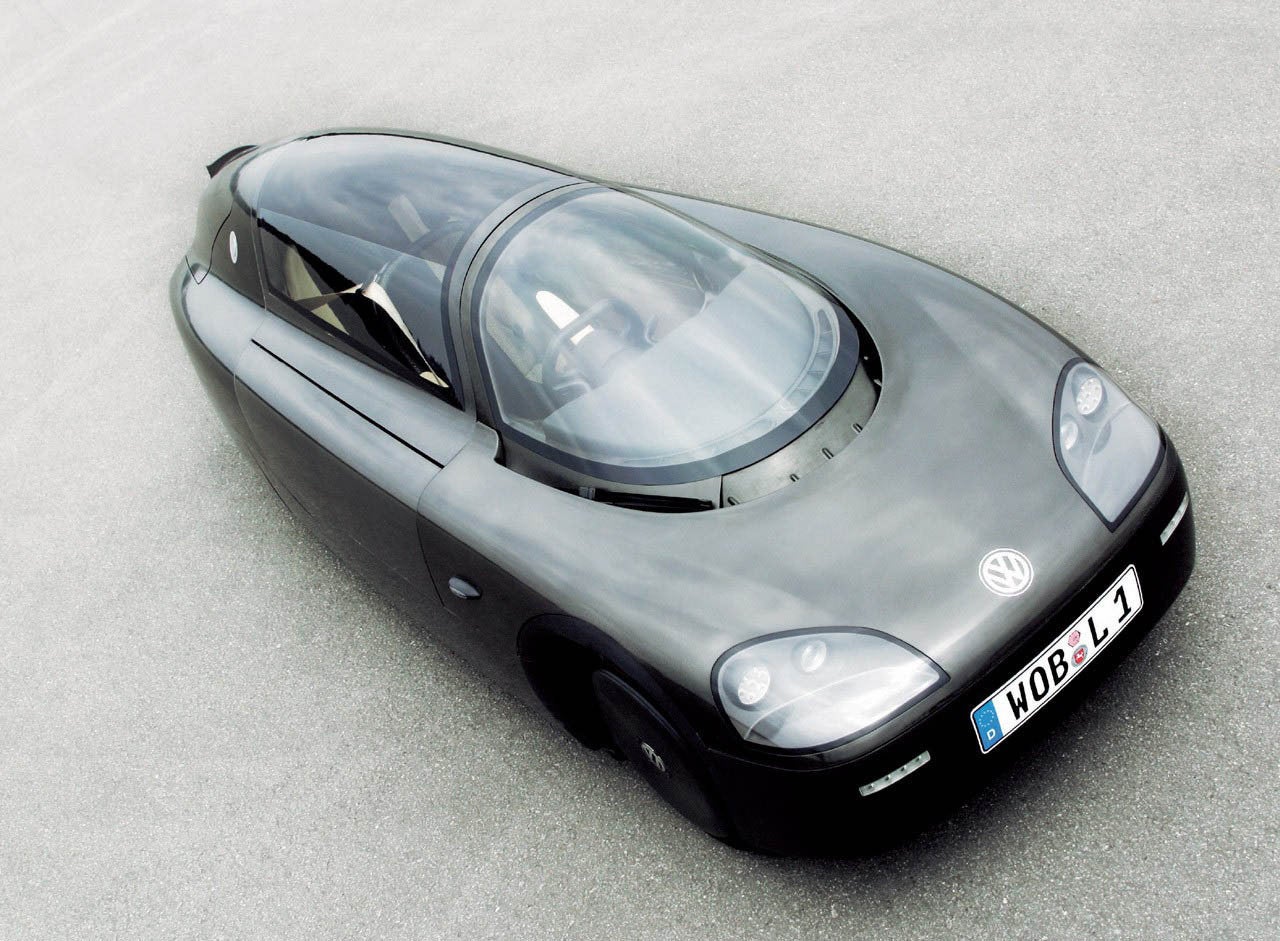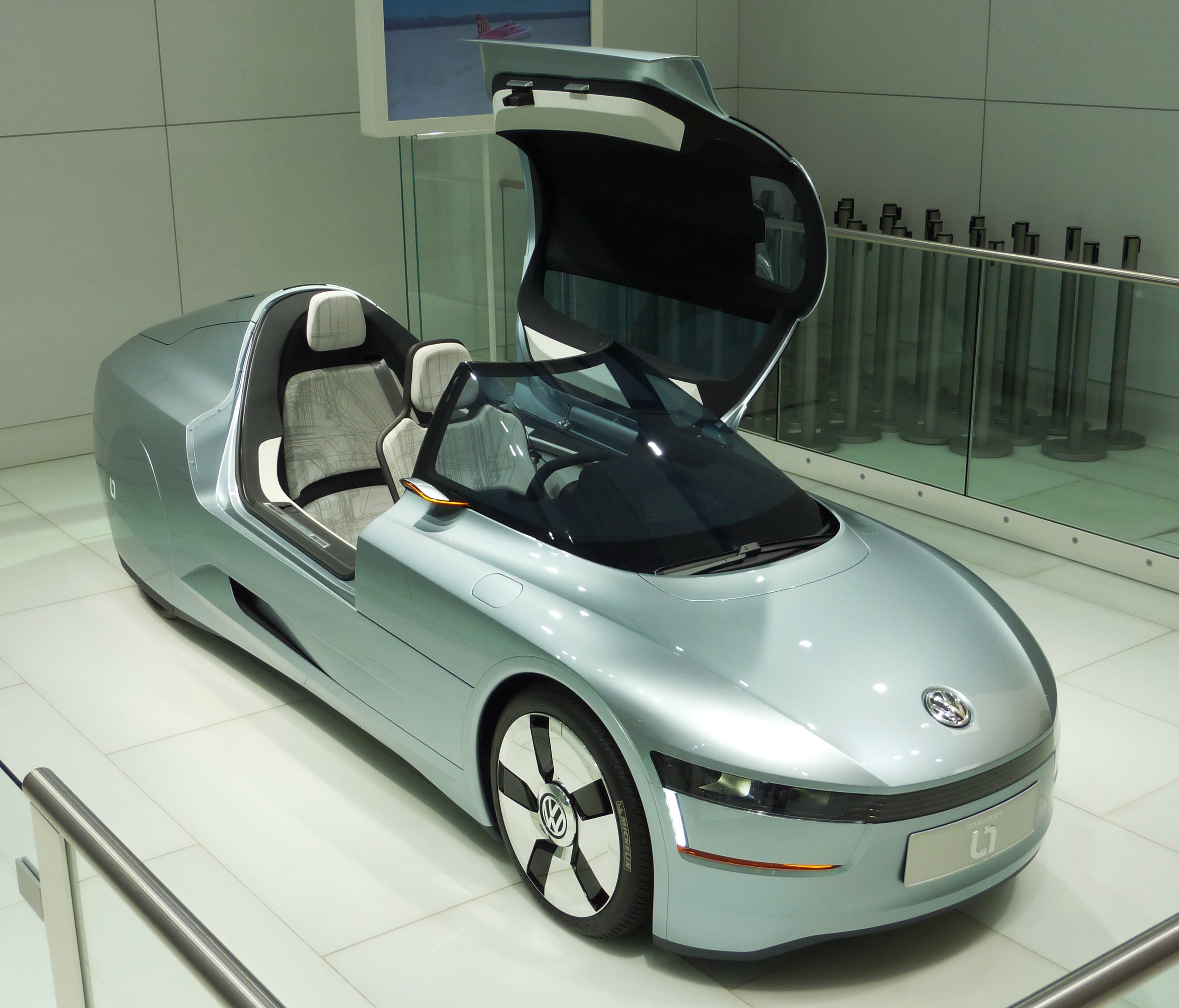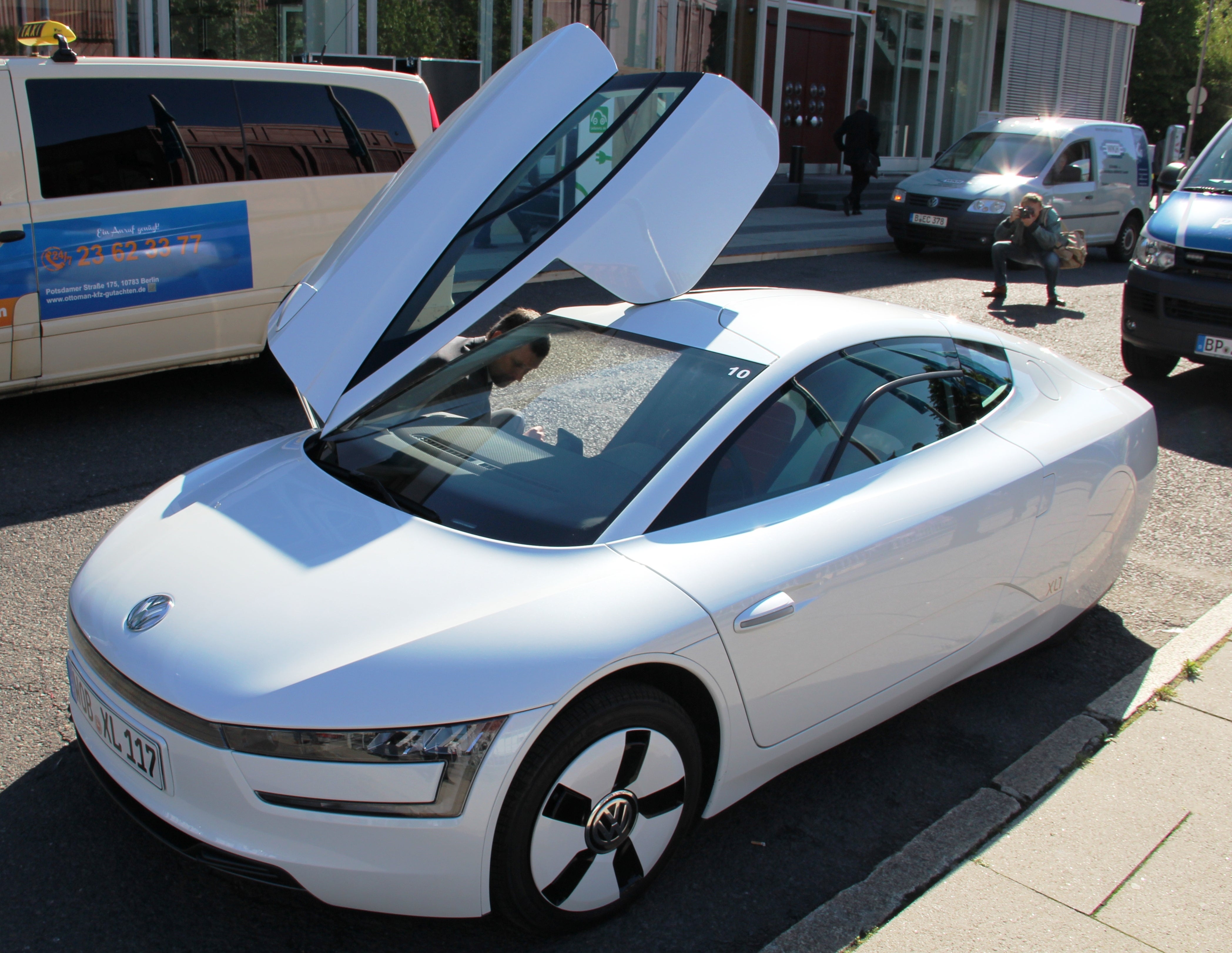 "bhtooefr" (bhtooefr)
"bhtooefr" (bhtooefr)
10/06/2016 at 22:49 ē Filed to: volkswagen, diesel, concept, efficiency
 11
11
 8
8
 "bhtooefr" (bhtooefr)
"bhtooefr" (bhtooefr)
10/06/2016 at 22:49 ē Filed to: volkswagen, diesel, concept, efficiency |  11 11
|  8 8 |

The Volkswagen 1-Liter-Auto concept, from 2002. It was one of Ferdinand Piechís three projects designed
to create a corporate culture of cheating to make the boss happy
as halo cars to demonstrate the technical prowess of Volkswagen - the other two being the Phaeton and the Veyron. The Phaetonís goal was to be the best luxury sedan in the world, the Veyronís to be the fastest car in the world while still being easy to drive, and the 1-Liter-Autoís goal was... to consume 1 liter of fuel for every 100 kilometers, or in Ďmurrican units, 235 miles per US gallon. And, it had to do this while actually being capable of decent speeds - top speed was 120 km/h, or about 75 mph.
They achieved that goal even with this prototype (which borrows heavy inspiration from the Messerschmitt/FMR microcars), but it would be over a decade before they brought ď1 liter carĒ into production, and they had to cheat to do it (and I donít just mean the Dieselgate cheats, although it may well have had those as well). This car, as far as I know, didnít have to cheat.
Aerodynamics
The first, and most obvious thing, is that it had extremely good aerodynamics - Volkswagen actually claimed a Cd of 0.159, and frontal area of 1.0 m 2 , for a total drag area of 0.159 m 2 . For comparison with a more normal eco-car, Car and Driver tested a 2014 Prius at 0.26 Cd and 2.22 m 2 frontal area, for a total drag area of 0.577 m 2 - over 3.6 times the aerodynamic drag. (Yes, the 2016 is lower drag, but I canít find frontal area figures for it, so...) Of course, some tradeoffs are required to get such low frontal area...

...like tandem seating. Narrow car, requires narrow seating configuration. In addition, itís about 130 mm, or 5", lower roof height than a Miata.
However, if you look closer at the seating... it leads into the next thing needed to achieve the 1.0 l/100 km goal.
Weight
This thing is silly light weight. Aerodynamics are important for high speed efficiency, but when accelerating from a stop, or climbing a hill, weight is the real killer. So, Volkswagen decided to just... not have weight. When money is no object, you can do that, you see.
Youíll note the mesh seats, thatís the first obvious sign of extreme lightweighting.
As far as the body, it was a magnesium (aluminum being too heavy, you see) space frame, with a carbon fiber skin. Plenty of titanium and magnesium components are scattered throughout the vehicle, including in the powertrain. Titanium wheel bearings with ceramic balls, carbon fiber wheels, crazy light suspension bits, etc., etc. And, custom (ultra-narrow, of course) tires, which also helped reduce rolling resistance.
The result? It weighs 290 kg, or about 639 lbs.
Powertrain
Now this is where things get a bit interesting. Itís got an 8.5 hp, 300 cc, single-cylinder direct injection, naturally aspirated, DOHC diesel engine. Aluminum block, titanium connecting rod. I saw a video a few years ago, in which this thing was actually driving, and... it sounds exactly like youíd think a diesel thumper would. However, the goal here is extreme efficiency.
The transmission is a 6-speed automated single-clutch gearbox. Nothing to write home about, except for the extreme light weight, and some things Volkswagen hid in !!!error: Indecipherable SUB-paragraph formatting!!! - the thingís a mild hybrid! Volkswagen had actually been working on very similar hybrid technology (and calling it that) since the 1980s (and that technology came to fruition in the 2010s), but they didnít even admit that this was a hybrid, unless you read between the lines.
The entire powertrain - engine, fluids, sandwich hybrid motor, and gearbox - weighs 61 kg, or about 134 lbs.
What came of it
In 2009, Volkswagen showed the L1 Concept, a somewhat closer to production version of the 1-Literís ideas, adapted to the Mk6 Golf-era design language that Volkswagen was moving to:

The L1 moved to an 800 cc, two-cylinder TDI, making 39 hp, and moved to a full hybrid configuration with a 14 hp electric motor (I donít have a combined power figure, and do not just add the electric to the diesel motor power), through a 7-speed DSG. Total drag area went up to 0.199 m 2 - so, still, a bit more than 1/3 of a Prius - and weight went up to 381 kg (840 lbs). Fuel consumption increased, however - 1.38 l/100 km, or 170 mpg, and that just wouldnít do. So, from the company that earned themselves an Ig Nobel for cheating on emissions, comes the product that cheated on hitting a fuel economy goal...

The XL1. It moved to a staggered side-by-side configuration (adding more drag), added more power - 47 hp engine, 27 hp electric motor, producing a combined output of 68 hp - and added a lot more weight (up to 795 kg, or 1753 lbs). Oh, and it also added a 5.5 kWh battery, for plug-in operation, and hereís where the cheat comes in. Volkswagen claimed 0.9 l/100 km, or 261 mpg - far better than the L1, even better than the old 1-Liter-Auto with its 8.5 hp thumper. However, this is a much wider, much heavier car - how can this be possible?
It becomes apparent what happened, though, when you realize how the NEDC test is run on a plug-in hybrid. (Weíre going to, of course, othewise ignore the fact that all of this, including the earlier carsí fuel economy figures, were done on NEDC, a test cycle thatís rather gentle, and easy to game.) The test is run starting with a fully charged battery, and the fuel used during that test is treated as the fuel consumption of the vehicle in all conditions - the electricity is kept track of, but often not reported by manufacturers. Volkswagenís range estimates, however, give away the real story. They claim 50 km on battery alone, and 500 km on both, with a 10 liter fuel tank. Well, that effectively means 450 km on 10 liters, or 2.22 l/100 km, or about 106 mpg - well over double the fuel consumption that Volkswagenís claimed.
What I did to try to chase the whale
So, I knew Iíd never be able to buy the original concept that I fell in love with. The L1 gave me hope that Iíd be able to buy something close enough, but the XL1 dashed those hopes.
Ultimately, I decided that if I wanted it, Iíd have to build it. So, that meant that Iíd need an engine, for starters... something cheap, small displacement, and diesel. To the List of Craig I went, and I ended up buying this thing:

ďThis thingĒ being a Ruggerini MD150. Itís a 654 cc, twin-cylinder, direct-injection, aircooled, diesel engine. Itís basically a generator engine, and it produces 12.6 hp @ 3000 RPM... except, that can be improved upon. You see, Ruggerini made another engine, the MD151, which is literally the same engine, but with the rev limiter set higher. It, instead, produces a far more respectable 16.3 hp @ 3600 RPM. (You might notice that 3600 RPM is a very common speed for generator engines - thatís because it divides evenly into 60 Hz. Thatís also why the MD150 exists - 3000 RPM divides evenly into 50 Hz.) And, the difference between the two engines? One screw on the fuel system.
I also started looking into things like suspension systems - IIRC, I decided on a massively narrowed VW Type 1 suspension as my best bet for the front, and I had decided that a three-wheeler would get into less legal trouble than a four-wheeler, so itíd be a simple swingarm for that. As far as the driveline, I think I had decided on some sort of aftermarket 6-speed intended for Harley-Davidson applications, because it was either that, or adapting some awful Royal Enfield gearbox to the engine - everything else is unitized.
The problem with all of this, though, is that I live in an apartment . Iíve never welded in my life. And, really, that kinda killed the project.
Upshot? That engine sits in my storage unit, just waiting to be used in something. I havenít even run it since I bought it.
That said, somewhere along the line, I discovered velomobiles - essentially, human-powered versions of the same concept. I eventually ended up getting a recumbent trike (which, if the cycling infrastructure around here were more conducive to it, Iíd ride to work more often than I actually do) to try to get a taste for it on the cheap, without the streamlining:

And, ultimately, I would like to build an electric assist velomobile of my own, something in between the European high-performance ultra-streamlined machines like the ď !!!error: Indecipherable SUB-paragraph formatting!!! Ē (actually a Milan velomobile) that Jason Torchinsky spotted in a Smart Brabus video, and huge (for something that a human pedals ) behemoths like the !!!error: Indecipherable SUB-paragraph formatting!!! . However, I donít think I feel the need to build something freeway capable any more - besides, thatís starting on the hardest mode, anyway.
So, what used to be your white whale, but is no longer?
 ADabOfOppo; Gone Plaid (Instructables Can Be Confusable)
> bhtooefr
ADabOfOppo; Gone Plaid (Instructables Can Be Confusable)
> bhtooefr
10/06/2016 at 23:31 |
|
Donít care if they cheated. Still want an XL1.
 facw
> ADabOfOppo; Gone Plaid (Instructables Can Be Confusable)
facw
> ADabOfOppo; Gone Plaid (Instructables Can Be Confusable)
10/07/2016 at 00:06 |
|
Agreed, though honestly I donít think itís fair to call plug-in hybrids cheating. Yeah, you wonít get the stated mileage on a long distance trip, but on the other hand you probably wonít be burning any gas on your commute. MPG is probably just entirely the wrong way to talk about their efficiency.
 Cť hť sin
> ADabOfOppo; Gone Plaid (Instructables Can Be Confusable)
Cť hť sin
> ADabOfOppo; Gone Plaid (Instructables Can Be Confusable)
10/07/2016 at 04:44 |
|
Iíve got as far as sitting in one. But no further, sadly.
 bhtooefr
> facw
bhtooefr
> facw
10/07/2016 at 05:40 |
|
I donít have a problem with plug-in hybrids, in fact, I considered buying one myself, and for those that can plug them in, I think theyíre the best way to electrify the fleet - no range anxiety, but most can commute on 100% electric. And, even with the XL1's shortcomings, itís still a damn efficient vehicle.
I have a problem with the way NEDC reports their efficiency, and I have a problem with Volkswagen setting the goal of a 1.0 liter/100 km car, and then abusing the NEDCís shortcomings in that regard to build a ď1.0 l/100 km carĒ that doesnít get that, and then declaring Mission Accomplished.

 torque
> bhtooefr
torque
> bhtooefr
10/08/2016 at 16:43 |
|
Great write up about Piechís 1-3 swan songs. With the 1L, Piech set a completely a ambitious (if somewhat misguided) goal. If Piech really wanted to maximize efficiency he should have approached it like he did the Phaeton with a top list of design requirements. ďVehicle needs to be able to achieve an efficiency equilivant to ability to travel 235 miles while using 33kw of energy, while being able to...
1) carry two people
2) minimally acceptable acceleration requirement say 0-60 in 15 seconds*
3) top speed minimally acceptable requirement = 75 mph
4) range of at least 200 miles (per fill-up / recharge)
*assumes this is the minimally acceptable acceleration requirement, small focus group testing would confirm this figure
I think his engineers would have ended up either with a hybrid (like they did) or more likely a pure electric.
I think what youíre after is creating the most efficient affordable daily driver as possible. Here are some thoughts if youíre interested, though you may know about all of them :)
As Iím sure you know, the most affordable & efficient DD (in the US at least) out there right now is the Nissan Leaf, however itís limited range could be a deal breaker.
The Volt could be a great option if your daily commute is less than 40 miles round trip itís possible you could keep it all electric. Gets progressively worse past its 40ish mile electric only range, dropping all the way down to about 33 mpg on a long trip.
Keeping things affordable & efficient (if only need to regularily carry two people) in the US market the winner has to be the 1st gen Insight with the 2004 - 2015 Prius a close second.†
Some other options currently available to think about: Ecomobile & Monotracer both enclosed motorcycles with fold down training wheels for stability in turns & when you come to a stop. Both are very sweet with carbon Kevlar monocoque chassis using BMW 11 or 1300 cc motorcycle engines. Unfortunately theyíre made in Europe & even used are still pretty expensive even used.
Promising but not available yet:
Teslas (S & X) are lovely, however their entry (purchase price) even used is still too high for average consumers. Of course, the Bolt and (Tesla) model III both look very promising but neither is available yet.
Same is true of these less conventional options (if any of them ever come out): Elio tadpole trike, Lit Motors C-1 all electric enclosed self balancing motorcycle. Then thereís the Raht Racer^, which is an all electric tadpole trike with which you can pedel to contribute to recharging the battery while driving. And the Archamoto electric tadpole trike.
Of course if your commute is less than 20 miles 1 way & youír ok not traveling freeway speeds, there are velomobile / recumbents like the recumbent you purchased... Lots of very sweet Velomobiles but all produced in very low volume
^the Raht Racer is sometimes called a velomobile
 torque
> torque
torque
> torque
10/08/2016 at 16:54 |
|
There are at least two interesting solar electrics too
Thereís a group of entrepreneurs who have more than met their goal on Indiegogo with a solar car called ďSionĒ on Indiegogo right now, would love to see them start producing these
https://www.indiegogo.com/projects/sion-a-solarcar-for-everyone-car-solar#/
And a Dutch University won the practical commuter class with a four seater called ďStellaĒ in 2013 World Solar challenge in 2013 & again in 2015 with†ďStella IIĒ, though I donít think thereís any intent (at least right now) to commercially produce this one, which is too bad b/c it seems to be a pretty sound design and it has over 500 mile range!
http://solarchargeddriving.com/2015/04/24/stella-worlds-most-practical-solar-powered-car/
 bhtooefr
> torque
bhtooefr
> torque
10/08/2016 at 17:36 |
|
Worth noting that 33.7 kWh is one gasoline gallon equivalent, and youíre looking at somewhere around 37.8-37.9 kWh per gallon of diesel. Ultimately, the right goal wouldíve been 1 kWh per 10 km, but yeah. However, I donít think they wouldíve chosen an electric in 2002 - it really wasnít until after 2010 or so that a BEV really made sense, Iíd argue.
Itís worth noting that what I daily drive right now is a 2016 Prius - more efficient than the older Priuses, and far more fun to drive, and in city fuel economy, it beats the Insight (because the Insight is incapable of shutting the engine down while still propelling the car).
If I had somewhere to plug in, the Prius Prime looks rather interesting, and would meet my range requirements.
The Elio is a project that I want to see succeed, but I donít think it will, and I think they were too slow to get going. The EcoModder crowd will still like it - their #1 interest is cheap, their #2 interest is efficient - but even they think itís vaporware. And, in 2017, the Elio wonít be able to virtue signal at all - electrification is required for that - which is, quite frankly, an important thing for eco cars to be able to do.
Arcimotoís also an interesting one, itíll be interesting to see how that goes.
Raht Racer is not a velomobile, Iím sorry. (This kind of thing actually creates huge debates in the velomobile community, I think consensus was basically that the Raht Racer is a human-electric hybrid motorcycle, and very much not a velomobile - itís predominantly an electric motorcycle with a tiny amount of human power, and itís nowhere near legal as a bicycle in any country. Similarly, I actually suggested using ďvelocarĒ to describe things like the Organic Transit ELF - things that want to be cars, are dependent on electric assistance to work, but fit within bicycle regulatory frameworks.)
 torque
> bhtooefr
torque
> bhtooefr
10/09/2016 at 19:08 |
|
Probably true early 2000 was improbable to be BEV and I agree (Elio vapor ware) and unfortunately I doubt the C-1 will Make it either & agreed on the Raht Racer itís not a velomobile.
Another interesting velomobile you might like (not out yet) is the Velotilt. In general I think electric assist velomobiles have real potential to take care of most commuter traffic in the US, of course not using highways, and further bike trails / lanes would be needed in many places outside of Seattle / Portland / MSLP